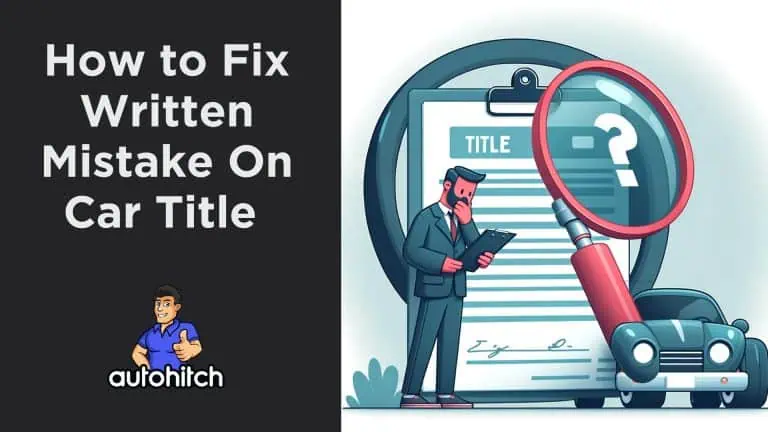Have you found or made a mistake on your title? Don’t Panic!
This happens all the time, and happened frequently at my dealership. Fortunately, every state has a simple process in place to get title errors corrected.
This comprehensive guide explains what to do if you sign a title incorrectly or spot other inaccuracies to ensure a smooth sales process.
Related Articles to Read:
- How to Erase Ink From a Car Title
- Can a Car Title Be Signed Over Twice?
- What Is Title Jumping and How to Avoid It?
- How to Transfer a Car Title After Death of Owner
- How to Transfer A Car Title To A Family Member
Table of Contents
Common Car Title Errors
While some title mistakes stem from deceptive intentions, most result from honest oversights and clerical mixups. Frequent errors include:
- Incorrect odometer entries
- Misspelled buyer/seller names
- Transposition of numbers in addresses
- Incomplete sales transactions
- Out-of-state title issues
- Incorrect signing spots
These types of inaccuracies typically surface during DMV registration transfers. However, both buyers and sellers have options for fixing title problems.
Fixing Title Errors as the Seller
As the seller, the title mistakes likely originated from you. But these common seller errors often have simple solutions:
- Minor Written Errors – Minor spelling slip ups or incorrect mileage numbers can be corrected by contacting your DMV, paying a small fee, and obtaining a replacement title.
- Buyer Backed Out – If another buyer originally signed the title but the deal collapsed, your DMV can still cancel the faulty document and reissue an accurate one.
- Unregistered Ownership Transfers – Illegally “jumping” titles by selling vehicles without registering ownership changes can only be fixed by titling it in your name first before attempting future sales.
Ideally address any self-created problems proactively before trying to complete sales agreements. But working promptly with your DMV makes seller title issues manageable hurdles to overcome.
Fixing Title Problems as the Buyer
Erroneous seller titles can derail sales if you’re the buyer. Review all title documentation carefully before finalizing transactions. Here are tips for remedying common buyer title setbacks:
- Obvious Title Errors – Notify sellers of mistakes like typos immediately and have them corrected via the DMV before proceeding.
- Already Signed Titles – Demand sellers erase prior buyer names/information at the DMV before taking ownership.
- Title Jumping Risks – Refuse sales if sellers’ names don’t match those listed on titles which signals illegal activity.
While more tedious to fix post-purchase, buyers can contact the DMV armed with bills of sale and old titles to resolve many title inconsistencies. Still, correcting issues before payments minimizes complications.
DMV Title Correction Processes By State
The specific rules and protocols for fixing inaccuracies on vehicle titles varies by state. Here is an overview of typical title correction processes in some key US states:
Texas Title Correction Process
- Identify the error – determine what information needs to be corrected, whether it’s names, vehicle details, odometer readings, etc.
- Prepare supporting documents – have copies of identification, registration, purchase agreements, or other papers proving the correct details ready.
- Complete Texas Application for Title Correction (Form VTR-276).
- Submit the application, supporting documents, and required fees (around $25) by mail to the Texas Department of Motor Vehicles (TxDMV).
- TxDMV will review the application and either approve or deny the correction. When approved, a corrected title will be issued.
California Title Correction Process
- Identify error type and appropriate correction method – minor typos can use a Statement of Facts form, major mistakes require full duplicate title.
- Fill out Notice of Information Change (DL-387) form or Statement of Facts (REG 256) form depending on error significance.
- Mail completed form, backups, and fee (around $25) to the California Department of Motor Vehicles (CA DMV).
- CA DMV reviews request and if approved will provide updated title or new corrected replacement.
- How to Transfer a Car Title to a Family Member in California
- How to Transfer a Car Title in California
Illinois Title Correction Process
- Contact local Secretary of State (SOS) office – discuss error and correction options.
- Gather supporting documents like proof of identity, ownership, correct information as needed.
- Submit either Application for Correction of Title (SOS 761) or Application for Duplicate Title (SOS 793) depending on error specifics.
- SOS reviews application and if satisfactory will issue fixed title.
New York Title Correction Process
- Report error to New York Department of Motor Vehicles (NY DMV) office – discuss correction process.
- Obtain either Vehicle Title Correction Application (MV-741) or Duplicate Title Application (MV-31) based on error type.
- Fill out form and supply supporting identification, ownership, and correct information documents.
- Submit completed application, documents, and fees (around $31) to NY DMV.
- NY DMV reviews request then provides updated title if correction approved.
Florida Title Correction Process
- Contact the Florida Department of Highway Safety and Motor Vehicles (FLHSMV) about the error and request a duplicate title in person, by mail, or online.
- Complete Form HSMV 82101 (Application for Duplicate Title).
- Pay $8.50 duplicate title fee and submit to FLHSMV.
- Carefully fill out the duplicate title with correct information when received. Double check accuracy.
- Transfer ownership as usual with the fixed duplicate title.
Always check state DMV websites for most current forms and instructions when correcting titles. Allow 2-4 weeks for new title processing and delivery.
Why Your Car Title Matters
A car or vehicle title, known legally as a Certificate of Ownership, confirms your ownership status. Having accurate title documentation is essential for registering a motor vehicle and conducting sales transactions.
Much like a driver’s license enables you to legally operate a car, a valid title permits transferring possession between sellers and buyers. Information displayed on titles includes:
- Vehicle make, model, year
- VIN
- Names and addresses
- Odometer readings
- Lienholder status
With this critical identifying and ownership data, it’s vital for titles to be completely accurate.
Preventing Future Title Problems
An ounce of title prevention is worth a pound of problem-fixing pain down the road. Here are proactive title tips:
For Sellers
- Carefully double check all vehicle and ownership information when filling out titles
- Only sign documentation at time-of-sale once payment is secured
- Consult your DMV to understand state title transfer protocols
For Buyers
- Inspect titles thoroughlychecking for errors before finalizing deals
- Research title histories through vehicle history report databases
- Be wary of out-of-state titles which have higher fraud risks
While the DMV provides critical assistance correcting existing title issues, taking a few preventative measures will help you avoid the most common mistakes motorists make.
Getting Professional Help for Title Troubles
Still stumped on how to fix a title problem? Seeking legal protections against potential title scams? Third-party title and registration specialists offer assistance:
- Title Correction Services – Companies like TitleSmith specialize in title transfers and delivering guaranteed clean certificates for vehicles. They can navigate DMV bureaucracy so you skip the hassle.
- Title Insurance Products – Special title insurance offerings add legal protections regarding mistakes made by prior owners, forged odometer issues, and undisclosed ownership transfers if problems develop post-sale.
Tap into third-party title resources so you can buy and sell cars with greater confidence and security.
The Bottom Line on Title Errors
Essentially minor title corrections only require contacting your local DMV, while significant inaccuracies may warrant help from professionals to shield yourself from major risks associated with titles signed incorrectly.
Still, reviewing title documentation before swapping money for ownership remains the best strategy for avoiding problems altogether.
Sources For This Article:
- https://www.reddit.com/r/cars/comments/3l4rcs/i_bought_a_used_car_yesterday_from_a_private/
- https://cartitles.com/what-to-do-when-your-car-title-is-signed-in-the-wrong-spot/
- https://www.flhsmv.gov/
- https://tax-office.traviscountytx.gov/files/vehicles/statement-fact-correct-title-error.pdf
- https://www.dmv.ca.gov/portal/online-change-of-address-coa-system/
- https://www.ilsos.gov/departments/vehicles/home.html
- https://dmv.ny.gov/replace-title-certificate



